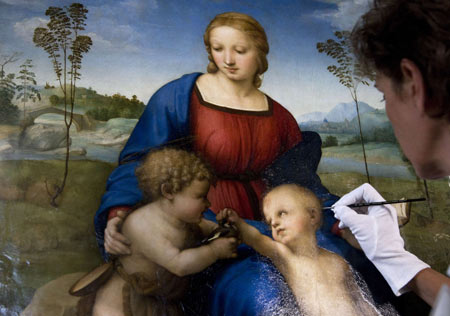 |
|
Fine arts technician Patrizia Riitana demonstrates the process in which Italian artist Raphael's 1506 oil-on-wood painting "Madonna of the Goldfinch" was restored at a laboratory in Florence October 23, 2008. After 10 years of painstaking study and restoration that tested both cutting edge technology and human patience, one of the greatest masterpieces of the Italian Renaissance is returning to the public. Raphael's "Madonna of the Goldfinch" is a survivor. The painting had been shattered into 17 pieces then nailed back together following a house collapse 1547. Picture taken October 23, 2008. [Agencies]
|
But the Opificio is no emergency room. It has everything but the pressures of time. It is a place of slow healing.
"In the past we decided not to restore something because the risks of damaging or altering the original were too great," said Ciatti, 53. "We see ourselves as a doctor who treats the patient as a whole rather than concentrating on a specific illness."
Raphael, who lived from 1483 to 1520, painted the panel in about 1506 as a gift for the marriage of Lorenzo Nasi, a rich wool merchant. Known in Italian as the Madonna del Cardellino, it shows the Virgin with two children symbolizing the young Christ and John the Baptist. The goldfinch is a symbol of Christ's future passion because the bird feeds among thorns.
When the Nasi house collapsed in 1547, the work shattered into 17 pieces. Ridolfo di Ghirlandaio, a Raphael contemporary, used nails to join the pieces and paint to hide fractures. It later became part of the collection of Florence's powerful Medici family, who commissioned several interventions aimed primarily at covering traces of the fissures.